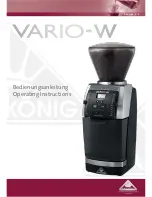
10
Please note:
Use pods conforming to the ESE standard, indicated on the pack
by the following symbol.
The ESE standard is a system accepted by leading
pod producers and enables espresso coffee to be
prepared simply and cleanly.
2. Place the small filter in the filter holder, making sure the
filter is correctly inserted in the slot as shown in fig. 13.
3. Insert the pod, centering it as far as possible on the filter
(fig. 20). Always follow the instructions on the pod pack to
position the pod on the filter correctly.
4. Attach the filter holder to the appliance. Always turn as far
as it will go (fig. 14).
5. Proceed as in points 5, 6 and 7 in the previous section.
9. HOW TO MAKE CAPPUCCINO OR LATTE
1. Prepare the espresso coffees as described in the previous
sections, using sufficiently large cups.
2. Press the button.
3. In the meantime, fill a pitcher with about 3.5 oz/100 grams
for each cappuccino or 6 oz/170 grams for each latte to be
prepared. In choosing the size of the pitcher, bear in mind
that the milk doubles or triples in volume.
Please note:
You are recommended to use skimmed or semi-skimmed milk at
refrigerator temperature (about 5°C/42°F).
4.
*Models with adjustable cappuccino only:
Make sure
the ring on the cappuccino maker is positioned downwards
in the CAPPUCCINO position and place the pitcher contain-
ing the milk under the cappuccino maker.
5. Wait until the light comes on (fig. 21). The light comes
on to indicate that the boiler has reached the ideal tem-
perature for steam production. As the boiler heats up, it is
normal for a little water and steam to be given off into the
drip tray.
6. Remove the cappuccino maker by rotating to the left (fig.
22). During this operation, avoid touching the boiler outlet
as it is hot. Then place the recipient containing the milk
under the cappuccino maker.
7. Dip the cappuccino maker in the milk for a few millimetres
(fig. 23). Turn the steam dial to the
ON position (fig.
24). Steam is delivered from the cappuccino maker, giving
the milk a creamy frothy appearance. For a creamier froth,
immerse the cappuccino maker in the milk and move the
container with slow up/down movements.
8. When the required temperature (the ideal is 60°C/140°F)
and froth density is reached, interrupt steam delivery by
turning the steam dial to the OFF position and press the
button.
9. Pour the frothed milk into the cups containing the espresso
coffee prepared previously. The cappuccino is ready. Sweet-
en to taste and if desired, sprinkle the froth with a little
cocoa powder.
Please note:
• To prepare more than one cappuccino, first make all the
coffees then at the end prepare the frothed milk for all the
cappuccinos.
• To make coffee again after the milk has been frothed,
cool down the boiler first or the coffee will be burnt.
To cool the boiler, place a container under the boiler outlet,
press the
button (fig. 15) and deliver water until the
light goes off. Press the button again and prepare the
coffee as described in the previous paragraphs.
You are recommended to deliver steam for a
maximum of 60 seconds and never to froth
milk more than three times consecutively.
10. MAKING HOT MILK (WITHOUT FROTH) (*MODELS
WITH ADJUSTABLE CAPPUCCINO ONLY)
To make hot milk without froth, proceed as described in the
above section, making sure the ring on the cappuccino maker is
positioned upwards in the “HOT MILK” position.
11. CLEANING THE CAPPUCCINO MAKER AFTER
USE
Important:
For hygiene reasons, the cappuccino maker should always be
cleaned after use.
Proceed as follows:
1. Deliver a little steam for a few seconds by turning the
steam dial (fig. 24). This causes the cappuccino maker to
discharge any milk left inside. Turn the appliance on again
by pressing the ON/OFF button.
*
Models with adjustable cappuccino maker:
2. With one hand, hold the cappuccino maker spout firmly,
with the other, release the cappuccino maker by turning it
anticlockwise, then pull off downwards (fig. 25).
3. Remove the steam connection nozzle from the spout by
pulling it downwards.
4. Wash the cappuccino maker and steam connection nozzle
thoroughly with warm water.
5. Move the ring upwards and make sure the two holes
shown by the arrows in fig. 26 are not blocked. If necessary,
clean with a pin.











































